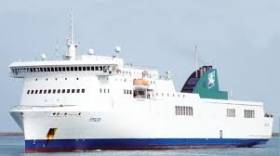Displaying items by tag: Fresh from Falmouth overhaul
Epsilon Three Years On Is Due Back Fresh From Overhaul
#Epsilon - Epsilon the ropox which has been on charter to ICG’s division Irish Ferries since 2013, is nearing completion of routine maintenance dry-docking at A&P Falmouth, writes Jehan Ashmore.
The 26,375 ton Epsilon is in dry-dock No. 2 while those sailings rostered by the ropax on Irish and French routes remain cancelled. The ferry is however scheduled to re-enter service next Saturday, April 23 on the Dublin-Holyhead. In addition to operating the Dublin-Cherbourg route that weekend with the oubound sailing from the Irish port also next Saturday.
Epsilon completed in 2011 is one of the popular and proven Visentini ropax class series designed by the Italian yard. Primarily, the ropax concept is to carry large amounts of ro-ro freight vehicles and not catering for high passenger capacity. In the case of Epsilon the passenger certificate is only for 500 passengers and accommodation based on 2 and 4-berth en suite cabins.
The 2.8km in freight vehicle deck lane metres of the Epsilon has contributed in boosting the fortunes of ICG, notably by increasing midweek capacity on the Irish Sea’s premier Dublin-Holyhead in support of daily sailings by Ulysses and high-speed craft, Jonathan Swift.
Passenger facilities on Epsilon are limited and so the marketing of the vessel on both routes are based on an 'economy class service'. Compared to the luxurious Oscar Wilde, where the cruiseferry has extensive amenities to offer on the Rosslare-Cherbourg route already underway. Next month 'Oscar' is to resume the summer-only Rosslare- Roscoff route.
Epsilon's Irish career has also covered sailings during annual dry-docking of Oscar Wilde on the Rosslare-Cherbourg service. On occasions the ropax has taken on additional business in transporting trade vehicles discharged at the Wexford port.






























































